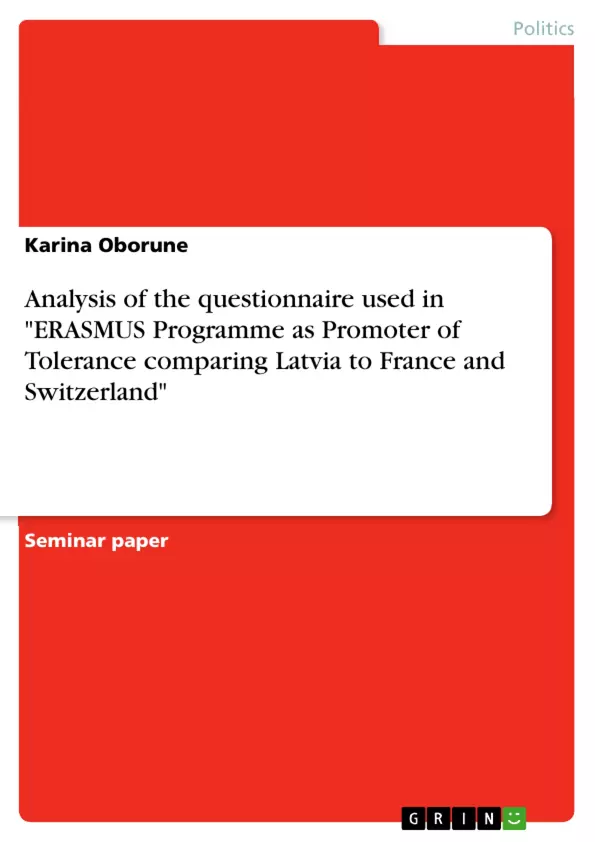I have analysed the questionnaire I have used in my MA thesis: the type of survey, sample size, sampling technique, sampling and non-sampling errors, margin of error, questionnaire design (response scale, general considerations, open-ended vs. closed-ended questions, reliability and validity) and missing data.
Inhaltsverzeichnis (Table of Contents)
- INTRODUCTION
- TYPE OF SURVEY
- SAMPLE SIZE
- SAMPLING TECHNIQUE
- SAMPLING AND NON-SAMPLING ERRORS
- MARGIN OF ERROR
- QUESTIONNAIRE DESIGN – RESPONSE SCALE
- Yes/No
- Yes/No/Don't know
- Likert scale
- QUESTIONNAIRE DESIGN – GENERAL CONSIDERATIONS
- OPEN-ENDED VERSUS CLOSED-ENDED QUESTIONS
- QUESTIONNAIRE DESIGN - RELIABILITY AND VALIDITY
- MISSING DATA
- CONCLUSION
Zielsetzung und Themenschwerpunkte (Objectives and Key Themes)
This paper analyses the questionnaire used in the author's Bachelor and Master thesis, titled "ERASMUS Programme as Promoter of Tolerance comparing Latvia to France and Switzerland." The research encompasses four EU Member States: France (Western European), Latvia (Eastern European), Switzerland (non-EU), and Hungary (Central European). The author aims to extend this research to all European states participating in the ERASMUS Programme in the future.
- Survey methodology and questionnaire design in the context of cross-national research.
- The application of different sampling techniques, specifically purposive and convenience sampling.
- The evaluation of various factors influencing the reliability and validity of survey data.
- The analysis of different types of errors in surveys, including sampling and non-sampling errors.
- The impact of questionnaire design choices on the effectiveness and representativeness of survey results.
Zusammenfassung der Kapitel (Chapter Summaries)
- Introduction: Introduces the author's research project, focusing on the ERASMUS Programme and its impact on tolerance in different European countries. This section outlines the study's scope and the author's future research aspirations.
- Type of survey: Discusses the different survey methodologies employed, including e-mail surveys and internet surveys. The advantages and disadvantages of each method are briefly considered, with specific attention paid to the potential for sampling bias in online surveys.
- Sample size: Explains the factors influencing the determination of sample size, including time constraints, budget, and the desired level of precision. The paper outlines the specific sample sizes used in the research and their representativeness in relation to the broader student populations at the participating institutions.
- Sampling technique: Delves into the sampling technique used in the research, highlighting the application of purposive sampling and its non-probabilistic analogue, quota sampling. The rationale behind this choice, including the need to adequately represent smaller groups within the sample, is explained.
- Sampling and non-sampling errors: Examines the different types of errors that can arise in surveys. The paper distinguishes between sampling error, which can be minimized by increasing sample size and improving sample design, and non-sampling error, which is more difficult to quantify and requires careful attention to every stage of the survey process.
- Margin of error: Defines the concept of margin of error as a measure of survey uncertainty and explains how it is influenced by sample size, sampling technique, and population size. The paper discusses the impact of different sample sizes on margin of error and the tendency of quota sampling to increase it.
- Questionnaire design – response scale: Discusses the importance of choosing an appropriate response scale for survey questions, focusing on three common options: Yes/No, Yes/No/Don't know, and Likert scales. The advantages and drawbacks of each option are considered, with emphasis on the need for balance between simplicity and accuracy.
- Questionnaire design – general considerations: Emphasizes the significance of clear instructions, engaging introductory questions, and expert input in the questionnaire design process. The author details their own approach to questionnaire design, highlighting the importance of a pilot test to identify and address any potential problems.
Schlüsselwörter (Keywords)
The main keywords and topics of this paper revolve around survey methodology and questionnaire design in a comparative research context, focusing on the ERASMUS Programme and its impact on tolerance. Key themes include: cross-national research, sampling techniques (purposive sampling, quota sampling, convenience sampling), survey errors (sampling error, non-sampling error), margin of error, response scales (Yes/No, Likert scales), and questionnaire design best practices. These themes are interwoven with the specific research context of the ERASMUS Programme and the study's focus on tolerance and intercultural understanding.
- Quote paper
- Karina Oborune (Author), 2010, Analysis of the questionnaire used in "ERASMUS Programme as Promoter of Tolerance comparing Latvia to France and Switzerland", Munich, GRIN Verlag, https://www.grin.com/document/145052



